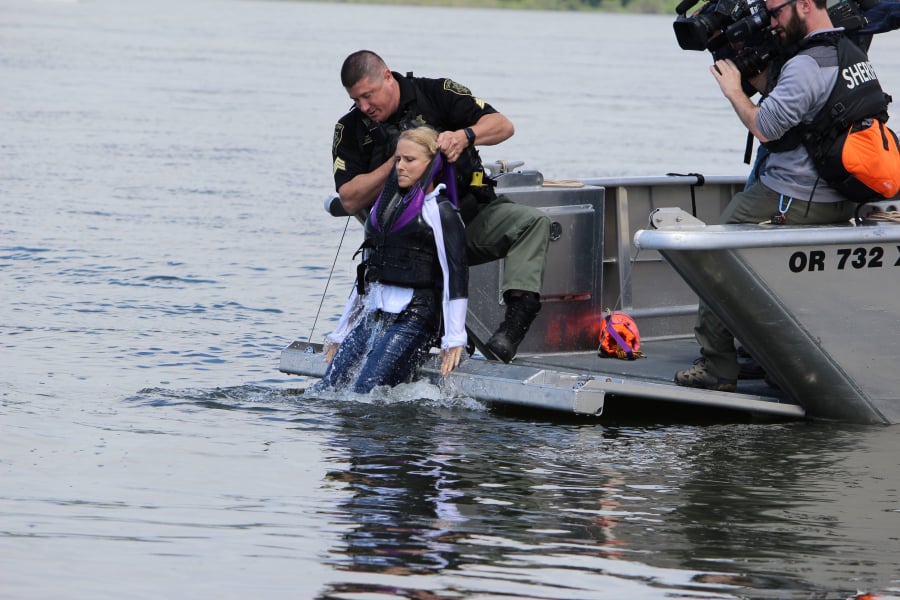As Ashley Massey of the Oregon Marine Board stood on a boat in the Columbia River, she had a question for onlookers.
“What do you do if someone falls in the water?” she asked. “Do you have a plan in place? Have a plan and make sure everyone in the boat knows what to do, and go through all the possible scenarios.”
Then, wearing street clothes and no personal flotation device (PFD), into the 56-degree water she went.
Onlookers were startled to see how quickly her ability to move and swim was impaired. She struggled to put on the life jacket that was thrown to her, even though she had only been in the water a matter of seconds.
Summer is upon us, and the waterways are getting crowded. It is now more important than ever to practice safe boating, and be prepared for the worst should it happen.
That’s why local agencies recently held a media event to raise awareness of the need for safe boating practices as we head into summer.
Members of the US Coast Guard, the Oregon Marine Board, Clark and Multnomah County Sheriffs, and the state parks from both Oregon and Washington put on demonstrations on such topics as preparing your boat and equipment for the season, how to maintain and properly use PFDs, and when to wear them. (Here’s a hint: all the time.)
There were discussions on the rules of the water, how to avoid accidents, and what to do if you are in one. The day started with Dan Kienle of the Coast Guard discussing how to make sure your boat and equipment is prepared for the season. That was followed by a demonstration by Washington State Parks Kaitlyn Arnes on PFD’s, including how they should fit, and how to care for and properly maintain them.
Then came testimony from Chris McMahon, a Hermiston, Ore., police officer who was involved in a high-profile boating accident that happened on the Columbia River in 2017.
McMahon was fishing the Buoy Ten fishery near Warrenton, Ore., when his boat was run over by a larger vessel. The accident was recorded by on-boat cameras.
In the video the approaching boat can be seen running directly toward McMahon’s boat.
“Another boat came running up on us, and as it got closer, we started yelling and waving,” McMahon said. “I could see his bow was high, so I stood up in the back to try to get their attention. That’s when I realized there was no one looking back at us.
“At that point I realized we did not have enough time to react.”
The other boat’s operator was sitting down and could not see McMahon’s boat, which was hit at nearly full throttle.
All of the anglers in McMahon’s boat went into the water prior to the impact. Only one of them was wearing a PFD, but it did not inflate.
When his party surfaced, McMahon realized they were still in great danger. They were being swept downstream by the outgoing tide, and they were being pushed toward a complex of old pilings.
They were saved by quick reactions from other boaters, but McMahon said he was traumatized by watching his friends struggle in the current.
In the video you can count about 9 seconds from the time the danger was spotted to when the anglers went into the water. There was no time to don PFD.
“Now I never go on a boat without everyone wearing life jackets,” he said. “It doesn’t do any good if it’s not on.
“I don’t ever want to go through that again,” he added.
STEPS TO SAFE BOATING
• Make sure your craft and all safety equipment are in good working order before you go on the water. That includes your PFD. Make sure it fits well, and wear it at all times.
• Plan ahead so everyone in the boat knows what their roll will be in case of an accident.
• Make sure that everyone in the boat is on the lookout for potential dangers, not just the driver. Let the driver know if you see anything of concern. Do not assume he has spotted the coming danger.
• Do not consume drugs or alcohol when operating a boat. Not only is it against the law, but it is one of the most common causes of boating accidents.
• Anyone operating a boat in Oregon or Washington is required to have a state-issued, valid boaters operator card.
• Learn the “rules of the road” and when on the water, follow them.
For more information, visit the Oregon Marine Board Safety page at: www.oregon.gov/osmb/boater-info/Pages/Safety-and-Education.aspx




